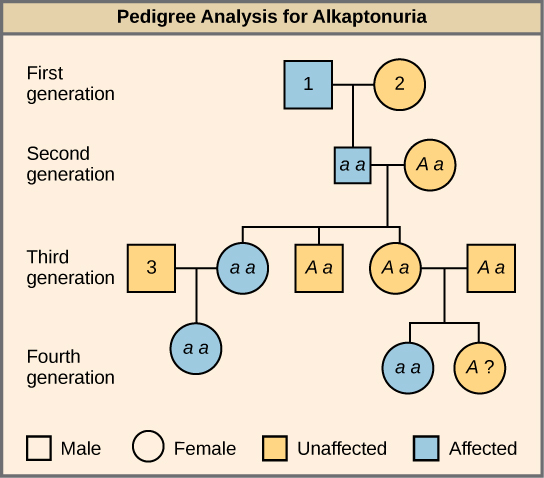Pedigrees
Introduction
You may be familiar with someone who has suffered from a genetic disorder. While human genetic disorders are widespread and very important to study, it is very challenging to investigate such diseases. One tool that geneticists have at their disposal is the ‘family pedigree‘. Let us explore more about this tool now.
Learning
Among the things that make it challenging to investigate genetic diseases are the facts that humans have a long generation time, select their own mates, and decide when and whether to have children. In addition, geneticists cannot perform crosses designed to help decipher how human genetic disorders are inherited. So how do we get around these problems? One key tool that is used by geneticists is a family pedigree. A pedigree is a chart like a family tree that shows genetic relationships among family members over multiple generations.
Pedigrees provide geneticists with a way to analyze information from many families to learn about the inheritance of a particular disorder.

In these diagrams, people are represented by symbols, usually circles for female and squares for male, and the bottom line represents the children of the couple above.
Dark symbols are used to indicate someone affected with a genetic condition, and unfilled symbols for those who are unaffected.

In this example, we can see several patterns emerge which inform us about the inheritance of the disorder. Let us review the pedigree generation by generation…
In Generation I:
- The father is affected.
- The mother is unaffected.
In Generation II:
- 1 out of the 2 children (1 boy, 1 girl) are affected
In Generation III:
- The affected male from Generation II has children with a carrier female.
- Among their children, 1 out of 3 children are affected (1 boy, 2 girls – one of which is affected)
- 2 out of 3 children are carriers (1 boy, 1 girl)
- The carrier female from Generation III has children with a carrier male.
- Among their 2 children, one was affected and one unaffected (the ‘?’ denotes that the second allele could be an ‘a’ or an ‘A’)
Summary
In this section, we have learned:
- A family pedigree can be used to identify patterns of inheritance within a family to determine the nature of the underlying genetic cause.
- In a pedigree, the appearance of symbols identifies the individuals, typically:
- Clear circle = unaffected female
- Dark circle = affected female
- Clear square = unaffected male
- Dark square = affected male
Sources:
Nickle, T., & Barrette-Ng, I. (2020, September 13). Pedigree Analysis. Retrieved May 21, 2021, from https://bio.libretexts.org/@go/page/4036
